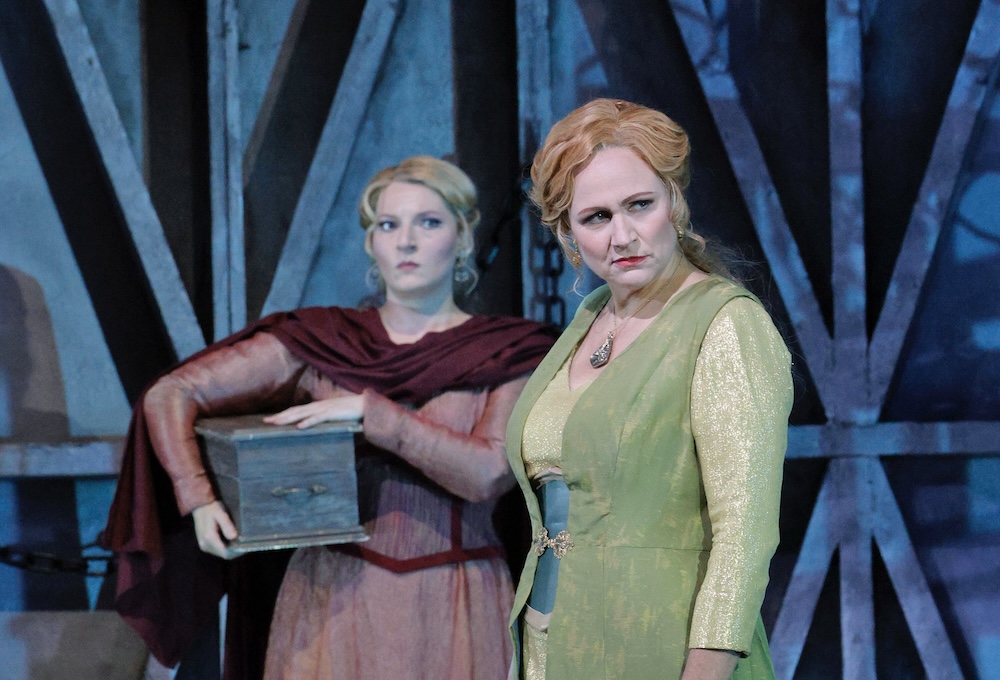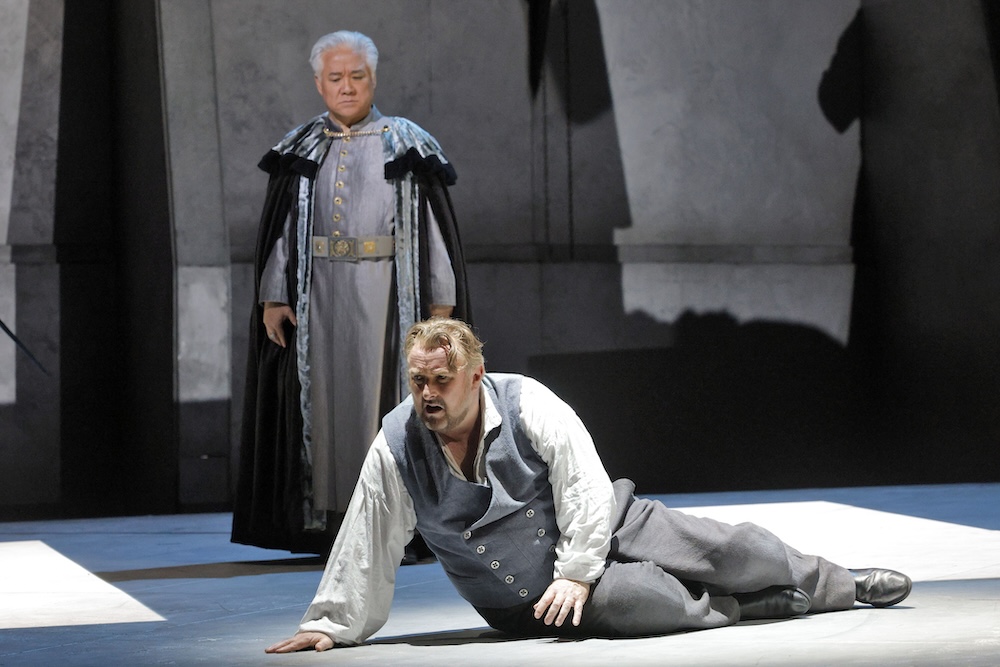In the 1870’s Richard Wagner built a special theater for his operas, a theater where the words of his poems might flow clearly from the stage into the hall. One hundred years later supertitles came into being, quickly making Wagner’s dream of reviving Greek tragedy a reality —supertitles actually allow intoned words to be understood, not to be simply felt.
While Wagner’s Bayreuth Festival famously indulges itself in the latest dramaturgical trends it does not avail itself of this more recent development. Supertitles, it should be argued, are critical to the appreciation of Wagner’s poems, surely the bedrock of his theater. Thus the Festspielhaus audiences at the splendid new Bayreuth Tristan this past summer were deprived of the intricacies, the complexities, and the subtleties of Wagner’s quite magnificent poem.
But not we San Franciscans who just now participated word-for-word in San Francisco Opera’s splendid account of Wagner’s Tristan und Isolde, a work reputed to be the operatic apotheosis of Romanticism. Conductor Eun Sun Kim assumed the production’s rhetorical stance in the un-staged overture. Avoiding a musical sweep, she carefully stated the famed initial, questioning chord, insisted on the overture’s intricate phrasing, then steadily built to the opera’s strategically recurrent mordent (note above, note, note below, note) that is Tristan and Isolde’s chain link of connection (lead photo). And finally, with Wagner, let it disappear into the unfolding tragedy.
The poem is a masterfully constructed opera libretto within the Wagnerian poetic. It is a treatise on the fatality of love and the philosophical impossibility of its fulfillment, told by contrasting light with darkness, day with night, this thesis expounded not without the complications of human loyalties. Obviously Tristan is not the same opera it was at its premiere one hundred fifty years ago, having since been subjected to the critical analyses accorded such masterpieces.
Scottish stage director Paul Curran however did not burden his production with any overriding critical concept, or any concept at all for that matter, allowing the words of his actors to determine where, how and when they moved, like in a sort of real life naturalism. Mr. Curran always placed his actors across the front of the stage facing us, where they sang Wagner’s poem exactly as it was projected on a screen just above the stage. It was much like a semi-staged opera.
The physical production, by British designer Robert Innes Hopkins, came from Venice’s Teatro La Fenice where it was previously staged by Mr. Curran. It consisted of two, rather small reversible wall units, a wooden trellis, a tree and a chair (at a cost of maybe 20 cents in operatic dollars). The lighting, by U.S. designer David Martin Jacques, was crudely effected.
Thus the production, or lack of, left Wagner’s masterpiece to Maestro Kim and the San Francisco Opera orchestra who rose magnificently to the occasion with the maestra’s usual vivid presence, the sound at one with the words that flowed clearly and easily from the stage. Orchestrally it was a measured, precise reading of Wagner’s meticulously nuanced score that could have seemed stolidly procedural had we not carefully followed the words of the poem. As it was we were totally immersed in Wagner’s complex, timeless, awesome gesamtkunstwerk soundscapes.

The exemplary cast as well rose to the occasion. Tristan was sung by New Zealand tenor Simon O’Neill, a singer whose voice exhibits a character tenor sound to current ears, but a sound that evokes the storied Tristans of San Francisco Opera’s earlier eras, notably Wolfgang Windgassen in 1970. Mr. O’Neill has solid technique that he employed to maximum effect in his Act III soliloquy, electrifying in its nuanced delivery, carefully paced by the maestra to find its two shattering conclusions.
Isolde was sung by German soprano Anja Kampe who looks very much the Irish maid of the Tristan legend. Mme. Kampe is a recognized Isolde having performed the role on the major German stages, though in this production she did not find the heroic and philosophic stature usually ascribed to Isolde. Never losing her beautifully focused, truly heroic tone she remained a solidly voiced heroine through her movingly straightforward “Liebestod” — though she skipped over Wagner’s final mordent as she soared to her long awaited union with Tristan.

Marke was sung by Korean bass Kwangchul Youn. Miscast last spring as Zarastro in The Magic Flute, he now shone with black voiced authority, exuding his profound suffering at Tristan’s betrayal. His famed Act II soliloquy was solemnly stated, without overt art song affect, the beat of his voice echoing his heavy heart as the scene was perfectly paced by the maestra. At the end of the opera he fully embodied the humanity that mourned the Romantic tragedy of the lovers.
Brangäne was sung by German mezzo soprano Annika Schlicht. Of similar bright voice to Isolde she was as much Isolde’s alter-ego as she was Isolde’s maid. The opera’s opening scene was the sparring of two shöne madchen in this production’s demystification of the Tristan legend, not a scene of an interior, personal, philosophic, heroic battle.
Kurvenal was sung by Austrian baritone Wolfgang Koch. Mr. Koch is of a quite beautiful, Italianate voice belying his scruffy persona in this production. The role was greatly diminished from its often heroic display of unwavering fealty. Of note was the offstage voice of the sailer’s song that opens the opera, sung by former Adler Christopher Oglesby (though he was on-stage). As well Mr. Oglesby made great impression as Act III’s on-stage shepherd who mimed playing Wagner’s exquisite English horn solo. Melot was sung by Adler Fellow Thomas Kinch.
Michael Milenski
War Memorial Opera House, San Francisco, October 25, 2024. All photos copyright Cory Weaver, courtesy of San Francisco Opera.